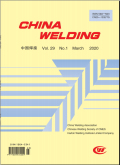- 钛学术文献服务平台 \
- 学术期刊 \
- 工业技术期刊 \
- 金属学与金属工艺期刊 \
- 中国焊接期刊 \
Effect of heat treatment on microstructure and properties of VG10 and 3Cr13 dissimilar welded joints
Effect of heat treatment on microstructure and properties of VG10 and 3Cr13 dissimilar welded joints
基本信息来源于合作网站,原文需代理用户跳转至来源网站获取
摘要:
Through laser swing welding of dissimilar steels, the microstructure and properties of welded joints of dissimilar steels under dif-ferent heat treatment processes were investigated. In the test, the equilibrium phase diagrams of the base materials 3Cr13 and VG10 were calculated by JMATPro software. The microstructures of the different regions of the welded joints after the original and heat treatment were analyzed by XRD and SEM, and the changes of the microhardness were tested. The test results show that a martensite-like structure is gener-ated at the base material on the 3Cr13 side of the original welded joint, and a non-convective mixing zone exists in the fusion zone on the VG10 side. At this location, a block-like, island-like structure is embedded in the base material. There were lamellar carbide formation on this structure. After heat treatment, the amount of carbides in the welded joints is reduced, but the primary carbides in the VG10 base metal are difficult to eliminate by heat treatment. In addition, the lamellar carbides in the VG10 side fusion zone are polymerized to form network carbides. The hardness of the base metal near the fusion line on both sides of the original welded joint is relatively large, and the hardness of the heat affected zone gradually decreases with increasing distance from the center of the weld. After heat treatment, the overall hardness of the welded joint has increased significantly. Among them, the hardness increase is greatest at the quenching temperature of 1050 °C, and VG10 can reach about 830 HV.

推荐文章
3Cr13弹簧表面异常组织分析
3Cr13材料
弹簧
表面异常组织
3Cr13侧定位钉的高效数控加工
侧定位钉
数控车床
编程
加工
3Cr13不锈钢循环热处理工艺探讨
不锈钢
循环热处理
含磨粒润滑条件下3Cr13涂层加速磨损机理研究
3Cr13涂层
磨粒
加速磨损试验
磨损机理
内容分析
关键词云
关键词热度
相关文献总数
(/次)
(/年)
引文网络
引文网络
二级参考文献 (54)
共引文献 (2)
参考文献 (8)
节点文献
引证文献 (0)
同被引文献 (0)
二级引证文献 (0)
1989(1)
- 参考文献(0)
- 二级参考文献(1)
1997(1)
- 参考文献(0)
- 二级参考文献(1)
2003(2)
- 参考文献(0)
- 二级参考文献(2)
2004(2)
- 参考文献(0)
- 二级参考文献(2)
2005(1)
- 参考文献(1)
- 二级参考文献(0)
2006(1)
- 参考文献(0)
- 二级参考文献(1)
2007(4)
- 参考文献(0)
- 二级参考文献(4)
2008(4)
- 参考文献(0)
- 二级参考文献(4)
2010(2)
- 参考文献(0)
- 二级参考文献(2)
2011(3)
- 参考文献(1)
- 二级参考文献(2)
2012(2)
- 参考文献(0)
- 二级参考文献(2)
2013(3)
- 参考文献(0)
- 二级参考文献(3)
2014(5)
- 参考文献(0)
- 二级参考文献(5)
2015(6)
- 参考文献(0)
- 二级参考文献(6)
2016(10)
- 参考文献(2)
- 二级参考文献(8)
2017(9)
- 参考文献(0)
- 二级参考文献(9)
2018(4)
- 参考文献(2)
- 二级参考文献(2)
2019(2)
- 参考文献(2)
- 二级参考文献(0)
2021(0)
- 参考文献(0)
- 二级参考文献(0)
- 引证文献(0)
- 二级引证文献(0)
引文网络交叉学科
相关学者/机构
期刊影响力
中国焊接
主办单位:
中国焊接协会
中国机械工程学会
焊接学会
哈尔滨焊接研究所
出版周期:
季刊
ISSN:
1004-5341
CN:
23-1332/TG
开本:
出版地:
哈尔滨市南岗区和兴路111号
邮发代号:
创刊时间:
语种:
eng
出版文献量(篇)
1017
总下载数(次)
0
总被引数(次)
2827
期刊文献
相关文献
推荐文献
- 期刊分类
- 期刊(年)
- 期刊(期)
- 期刊推荐
一般工业技术
交通运输
军事科技
冶金工业
动力工程
化学工业
原子能技术
大学学报
建筑科学
无线电电子学与电信技术
机械与仪表工业
水利工程
环境科学与安全科学
电工技术
石油与天然气工业
矿业工程
自动化技术与计算机技术
航空航天
轻工业与手工业
金属学与金属工艺
中国焊接2022
中国焊接2021
中国焊接2020
中国焊接2019
中国焊接2018
中国焊接2017
中国焊接2016
中国焊接2015
中国焊接2014
中国焊接2013
中国焊接2012
中国焊接2011
中国焊接2010
中国焊接2009
中国焊接2008
中国焊接2007
中国焊接2006
中国焊接2005
中国焊接2004
中国焊接2003
中国焊接2002
中国焊接2001
中国焊接2000
中国焊接1999

 免费查重
免费查重










